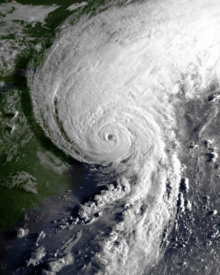 Bob approaching New England near peak intensity on August 19 | |
| Meteorological history | |
|---|---|
| Formed | August 16, 1991 |
| Extratropical | August 20, 1991 |
| Dissipated | August 29, 1991 |
| Category 3 major hurricane | |
| 1-minute sustained (SSHWS/NWS) | |
| Highest winds | 115 mph (185 km/h) |
| Lowest pressure | 950 mbar (hPa); 28.05 inHg |
| Overall effects | |
| Fatalities | 17 |
| Damage | $1.5 billion (1991 USD) |
| Areas affected | North Carolina, Mid-Atlantic states, New England, Atlantic Canada and Iberian Peninsula |
| IBTrACS | |
Part of the 1991 Atlantic hurricane season | |
Hurricane Bob was one of the costliest hurricanes in New England history. The second named storm and first hurricane of the 1991 Atlantic hurricane season, Bob developed from an area of low pressure near The Bahamas on August 16. The depression steadily intensified, and became Tropical Storm Bob late on August 16. Bob curved north-northwestward as a tropical storm, but re-curved to the north-northeast after becoming a hurricane on August 17. As such, it brushed the Outer Banks of North Carolina on August 18 and August 19, and subsequently intensified into a major hurricane (Category 3 or greater on the Saffir–Simpson scale). After peaking in intensity with maximum sustained winds of 115 mph (185 km/h), Bob weakened slightly as it approached the coast of New England.
Bob made landfall twice in Rhode Island as a Category 2 hurricane on August 19, first on Block Island and then in Newport. Upon doing so, it became the only hurricane to make landfall in the contiguous United States during the 1991 season. Moving further inland, Bob rapidly weakened, and deteriorated to a tropical storm while emerging into the Gulf of Maine. Shortly thereafter, Bob made landfall in Maine as a strong tropical storm early on August 20. Bob entered the Canadian province of New Brunswick a few hours later, where it transitioned into an extratropical cyclone. By August 21, the remnants of Bob crossed Newfoundland and re-emerged into the open Atlantic Ocean. The remnants traveled a long distance across the northern Atlantic Ocean, and finally dissipated west of Portugal on August 29.
Bob left extensive damage throughout New England in its wake, totaling approximately $1.5 billion (1991 USD, $3.36 billion 2024 USD). This made it one of the costliest United States hurricanes at the time; as of 2013, it ranked thirty-second in the category. But some sources say that Bob might have caused as much as $3 billion (1991 USD$, 6.71 billion 2024 USD) in damage.[1][2][3] In addition, eighteen fatalities were reported in association with Bob.[4][5][6] The loss of life and most of the damage occurred as a result of high winds and rough seas. There were six confirmed tornadoes during its passage. Bob is the most recent hurricane to hit the New England states directly as a hurricane.[7]
- ^ "Storm Preparation-Hurricane Bob". The Hour. September 2010. Archived from the original on June 12, 2018. Retrieved June 5, 2018.
- ^ "Hurricane Bob". Hurricanes, Blizzards and Noreasters. Retrieved June 5, 2018.
- ^ Top Five Houstonians for Hurricanes (Report). Houston Press. Retrieved December 13, 2021.
- ^ "The Hunt for Hurricanes". Scholastic. Archived from the original on May 30, 2018. Retrieved June 5, 2018.
- ^ "What Lessons Did New England Learn". NECN. March 25, 2014. Retrieved June 5, 2018.
- ^ "Governor M. Jodi Rell". Connecticut Governor Site. Retrieved September 11, 2021.
- ^ Pasch, Richard; Berg, Robbie; Hagen, Andrew (January 25, 2022). Tropical Cyclone Report: Hurricane Henri (PDF) (Report). Miami, Florida: National Hurricane Center. Retrieved March 5, 2022.